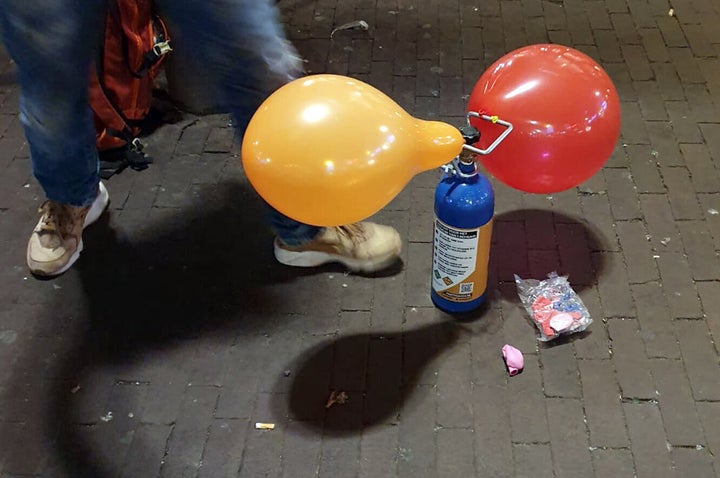
The sale and possession of laughing gas are soon to be banned as part of a plan to reduce antisocial behaviour.
The new drug misuse laws would prosecute anyone with nitrous oxide gas in public. Anyone with a “legitimate reason” would be free from prosecution, such as chefs who often use it in products like whipped cream or for freezing and chilling food. The gas is also used for pain relief during childbirth or dental treatment.
Currently, the Psychoactive Substances Act bans the knowing or careless use of nitrous oxide for inhalation. However, the British Compressed Gases Association wants a ban on all direct consumer sales and to make stricter laws.
An official announcement may be made as part of the government’s antisocial behaviour strategy which is due to be published around the same time, with any possible laws needed to pass the change likely by the summer.
Some people are being left with spinal cord and nerve damage after doing copious amounts of balloons – or nitrous oxide – a neurologist has warned.
This weekend saw millions of people flock to Notting Hill Carnival, as well as festivals up and down the country, and it seems that on the ground there’s been a resurgence in people enjoying the effects of the drug, also known as laughing gas.
But its popularity is also causing an “epidemic” of nitrous oxide-induced spinal cord and nerve damage, says Nikos Evangelou, a consultant neurologist in Nottingham, who added it’s “terrifying” to see young people paralysed from laughing gas.
Nitrous oxide (or Nos) is typically inhaled from a balloon and has an instant effect, slowing down the brain and body’s responses. Some people will feel euphoria and calmness, others may get the giggles (hence the nickname laughing gas), while others can end up hallucinating or experiencing sound distortions.
You’ve probably seen the shiny metal canisters discarded on the floor. For the uninitiated, those canisters are typically emptied out into a balloon, and then people inhale the gas from the balloon. This is because if the gas is inhaled directly from the canister it can cause your throat muscle to spasm and stop you breathing.
This week alone, neurologist Nikos Evangelou has seen three patients impacted by nitrous oxide, one of which had to be hospitalised. “It could be a bad week, but I fear for the many patients that have not seen their family doctor, or [for whom] the condition is not recognised and left untreated,” he tells HuffPost UK.
“In the UK we have more than 100 neurology centres so you can imagine the scale of the potential problem.”
Nerve damage is happening because nitrous oxide interferes with vitamin B12 and makes it stop working, says Evangelou.
“Vitamin B12 is very important for the function of the myelin – the insulation of the nerve cells,” he explains. “It [nitrous oxide] causes damage of the myelin and then damage of the nerves.
“We are increasingly seeing patients with long-lasting damage of the nerves as the use is increasing.”
Some people who are prolific users of nitrous oxide are experiencing permanent issues, such as paralysis. “Increasingly young people are using large canisters of nitrous oxide and some use it daily,” says Evangelou.
“Some people seem to recover very slowly, over months, but others have been left with what appears to be permanent damage.
“We don’t know how many recover fully. This study has not been done.”
He warns “there are dangers ahead” for those who take the drug daily, and for those who take it but have low vitamin B12 levels (for example, vegans who aren’t taking vitamins).
Most recently the drug made headlines following the death of Kayleigh Burns, 16, who was seen inhaling nitrous oxide at a house party before complaining of feeling “too hot”. Burns, who was asthmatic, later collapsed and was taken to hospital, but tragically died.
Her family are now trying to raise awareness of the dangers of the drug, while asking the government to ban its use, or at least implement an age limit.
There’s no penalty for possession of nitrous oxide, however supply and production can get you up to seven years in prison, or a fine, according to information site, Frank.

Health professionals are increasingly taking to Tiktok to try and warn young people of the dangers of nitrous oxide.
Dr David Nicholl, a neurologist at Sandwell and West Birmingham NHS trust, said there was an “epidemic” of young people being admitted to hospital “off their legs” because they’d been taking nitrous oxide – or ‘whippits’.
“Some of them have life-changing neurological injuries,” he explained in the video. “You need to be aware that this stuff is dangerous.”
Nicole Lee, who is a burns matron for Chelsea and Westminster Hospital NHS Foundation Trust, is increasingly seeing people presenting with injuries on their thighs from the canisters. “Patients are coming into the service following inhalation of the gas. With these larger canisters they’re resting them between their legs,” she explained in a Tiktok awareness video, “which is then leading to cold injuries being seen within the leg area.”
People are having to have skin grafts, she added, because when the gas is discharged from the canister, it grows extremely cold very quickly. But because the gas alters people’s senses, sometimes they don’t realise what’s happened “until it’s too late”.
The Bristol Drugs project has shared some helpful advice for reducing the harm from doing nitrous oxide:
- Always dispense nitrous oxide into a balloon, as using it straight from the dispenser will put you at risk of lung and throat damage because the gas being released is so cold.
- Don’t keep re-breathing a balloon for a long time. After you’ve inhaled from a balloon a few times there won’t be any nitrous oxide left and you’ll end up starving your brain of oxygen.
- Sit down to take it to avoid falls or accidents.
- Avoid using it too often as chronic use can lead to Vitamin B12 deficiency.
- Be aware that nitrous oxide makes the effects of other drugs stronger.
- If someone collapses or becomes unresponsive after taking nitrous oxide, seek immediate medical attention.
- Dispose of used canisters properly. They can be recycled.